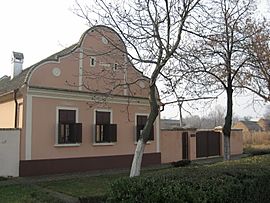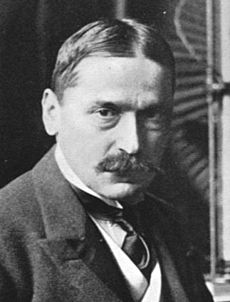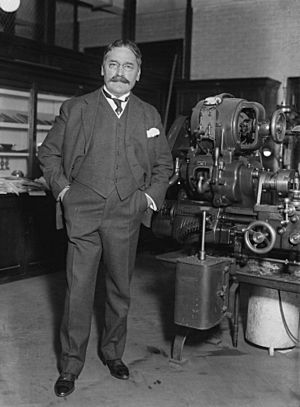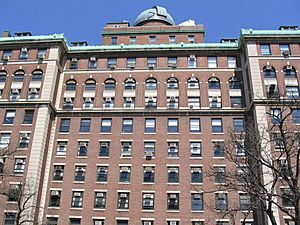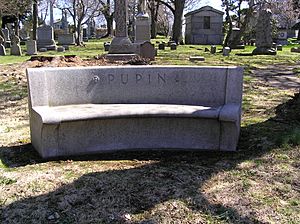Mihajlo Pupin facts for kids
Quick facts for kids
Mihajlo Idvorski Pupin
Михајло Идворски Пупин |
|
|---|---|
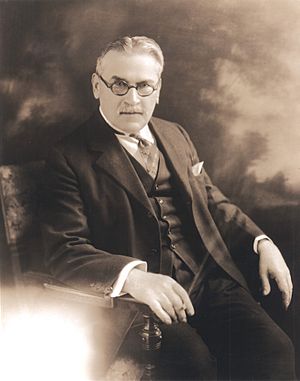 |
|
| Born | 9 October 1854 |
| Died | 12 March 1935 (aged 80) New York City, New York, U.S.
|
| Nationality | Serbian |
| Citizenship | Austrian (1858–1883) American (1883–1935) |
| Alma mater | Columbia University (BA) University of Berlin (PhD) |
| Known for | Long-distance telephone communication |
| Awards | Elliott Cresson Medal (1905) IEEE Medal of Honor (1924) Edison Medal (1920) Pulitzer Prize (1924) John Fritz Medal (1932) |
| Scientific career | |
| Fields | |
| Doctoral students | Robert Andrews Millikan Edwin Howard Armstrong |
| Signature | |
Mihajlo Idvorski Pupin (also known as Michael Pupin) was a famous Serbian-American physicist and inventor. He was also a physical chemist and a philanthropist, meaning he used his wealth to help others.
Pupin is most famous for his many inventions. One of his biggest achievements was finding a way to make long-distance telephone calls much clearer. He did this by adding special coils (called "loading coils" or "Pupin coils") to telephone wires. This invention was so important that it was named "pupinization" after him!
He also helped start important organizations. He was a founding member of the National Advisory Committee for Aeronautics (NACA) in 1915, which later became NASA. He also helped create the American Mathematical Society and the American Physical Society.
In 1924, Pupin won a Pulitzer Prize for his autobiography, which is a book about his own life. He was chosen to lead many top science and technology groups, like the American Institute of Electrical Engineers. From 1912 to 1920, he was an honorary consul for Serbia in the United States. He also played a role in deciding the borders of the new country called the Kingdom of Serbs, Croats and Slovenes.
Contents
- Early Life and School Days
- Studying in America and Earning a PhD
- Pupin Coils and Their Impact
- Research During World War I
- Helping Shape Yugoslavia's Borders
- Mihajlo Pupin's Foundations
- Literary Works
- Pupin Hall at Columbia University
- Pupin's Patents
- Awards and Recognitions
- Private Life
- Legacy
- See also
Early Life and School Days
Mihajlo Pupin was born on October 4, 1858. His birthplace was a village called Idvor in what was then the Austrian Empire. Today, Idvor is part of Serbia.
Pupin went to elementary school in his hometown. He attended a Serbian Orthodox school and later a German elementary school. He then went to high school in Pančevo. He was a brilliant student there. A local priest noticed his great talent and helped him get a scholarship.
Because he was involved in a group called "Serbian Youth," which had problems with the police, Pupin had to leave Pančevo. In 1872, he moved to Prague to continue his studies. However, his father died in 1874. At just 16 years old, Pupin faced money problems and decided to move to the United States.
Studying in America and Earning a PhD
For the next five years in the United States, Pupin worked hard at different jobs. He worked as a manual laborer, including at a biscuit factory in New York City. During this time, he taught himself English, Greek, and Latin. He also gave private lessons to earn money.
In 1879, he passed his tests and entered Columbia College. There, he became known as an amazing athlete and a smart student. He was very popular and was even elected president of his class. In 1883, he graduated with high honors and became an American citizen.
After finishing his studies in physics and mathematics, Pupin went back to Europe. He first studied in the United Kingdom from 1883 to 1885. Then, he earned his Ph.D. from the University of Berlin in Germany. In 1889, he returned to Columbia University. He became a teacher of mathematical physics in the new Department of Electrical Engineering. Pupin's early research helped develop ways to detect radio waves and analyze electric currents.

Pupin was also one of the first to study X-ray imaging. He learned about Röntgen's discovery of X-rays. These rays could pass through things like wood and thin metals, leaving marks on a photographic plate. Pupin tried this himself. On January 2, 1896, he successfully made X-ray images using a special vacuum tube.
Later, inventor Thomas Edison gave Pupin a screen made with calcium tungstate. When placed in front of the film, this screen made the X-ray exposure time much shorter. It went from one hour to just a few minutes! Pupin realized that primary X-rays created secondary X-rays. He gave a lecture about his X-ray work at the New York Academy of Sciences. He was the first person to use a fluorescent screen to improve X-rays for medical use.
A surgeon in New York, Dr. Bull, asked Pupin to take an X-ray of a patient's hand. The patient had lead shot from a shotgun injury. The first try failed because the patient was too nervous to stay still for an hour. In another attempt, the Edison screen was used. X-rays passed through the hand, making the screen glow. This glow then exposed the photographic plate. A good image was made in just a few seconds. It clearly showed the lead shot, helping Dr. Bull remove them quickly.
Pupin Coils and Their Impact
Pupin received a patent in 1899 for his loading coils, often called "Pupin coils." This invention was based on earlier work by Oliver Heaviside. The importance of Pupin's patent was clear when a major company, American Telephone & Telegraph (AT&T), bought the rights to it. This made Pupin very wealthy.
Even though AT&T bought Pupin's patent, they didn't use it much themselves. They already had their own similar technology. However, they bought Pupin's patent to make sure they controlled this incredibly valuable invention. It could greatly extend the range of long-distance telephone calls, especially underwater ones.
Research During World War I
When the United States joined World War I in 1917, Pupin was working at Columbia University. He led a research group focused on finding ways to detect submarines underwater.
With his fellow professors, Wils and Morcroft, he did many experiments. They worked to find submarines near Key West and New London. He also researched how to improve communication between different places. During the war, Pupin was part of the state council for research. He also served on the state advisory board for aeronautics (things related to flying). President Warren G. Harding praised Pupin for his important work during the war.
Helping Shape Yugoslavia's Borders
By World War I, Pupin was known for his strong Serbian pride as much as for his science. He believed that the assassination of Franz Ferdinand in 1914 was caused by earlier events. He felt that Serbian identity was a natural part of every true Serb.
Because he was an important person in America, Pupin took part in the Paris peace conference after the war. This is where the borders of the new country, the Kingdom of Serbs, Croats and Slovenians (later Yugoslavia), were drawn. The government asked Pupin to stay in Paris for two months during these talks in 1919.
An earlier agreement from 1915, called the London Agreement, planned for Italy to get Dalmatia. Also, France, England, and Russia wanted Serbia to give up some land to Romania and Bulgaria. Romania was supposed to get Banat, and Bulgaria a part of Macedonia.
During these difficult border talks, Pupin personally wrote a letter to American President Woodrow Wilson on March 19, 1919. Pupin gave Wilson information about the history and people of the border areas. These areas included Dalmatia, Slovenia, Istria, Banat, Međimurje, Baranja, and Macedonia. Based on Pupin's information, President Wilson decided not to recognize the London Agreement.
Mihajlo Pupin's Foundations
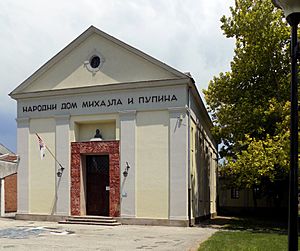
In 1914, Pupin created a fund called "Fund Pijade Aleksić-Pupin." He set it up within the Serbian Academy of Sciences and Arts. He did this to honor his mother, Olimpijada, for all her support. Money from this fund helped schools in old Serbia and Macedonia. Scholarships were given out every year. A street in Ohrid was named after him in 1930.
He also started a separate "Mihajlo Pupin fund" using his own money in Yugoslavia. He later gave this money to an organization called "Privrednik." This was to help young people get an education and to give prizes for great achievements in agriculture. It also helped his hometown of Idvor by giving prizes to students and supporting the local church.
Thanks to Pupin's donations, the library in Idvor got a reading room. Training for young people in agriculture was started. Also, electricity and a water system were brought to Idvor. Pupin also set up a foundation at the Museum of Natural History and Arts in Belgrade. This foundation's money was used to buy art from Serbian artists for the museum. It also helped print certain books. Pupin put a million dollars into these foundations.
In 1909, he helped create one of the oldest Serbian immigrant groups in the United States. It was called "Union of Serbs – Sloga." This group aimed to bring Serbs in America together and offer help. It also worked to keep their culture and traditions alive. This organization later joined with three other groups to form a larger Serbian national foundation. Pupin was one of its founders and its president for many years (1909–1926).
He also organized "Kolo srpskih sestara" (Circle of Serbian sisters). This group collected aid for the Serbian Red Cross. Pupin also helped gather volunteers to travel to Serbia during World War I. He did this with the help of a Serbian patriotic group called the "Serbian National Defense Council," which he founded and led.
Pupin used his own money to make sure food supplies reached Serbia. He also led a committee that helped war victims. He founded the Serbian society for helping children. This group provided medicine, clothes, and shelter for children who had lost their parents in the war.
Literary Works
Besides his inventions, Pupin wrote many scientific articles and reviews. He also wrote a 396-page autobiography called From Immigrant to Inventor (1923). This book won him the annual Pulitzer Prize for Biography or Autobiography. It was published in Serbian in 1929 with the title From pastures to scientist. He also published other books, including:
- Pupin Michael: Thermodynamics of Reversible Cycles in Gases and Saturated Vapors, 1894.
- Pupin Michael: Serbian Orthodox Church (South Slav Monuments), 1918.
- Pupin Michael: Yugoslavia, 1919.
- Pupin Michael: The New Reformation; from Physical to Spiritual Realities, 1927.
- Pupin Michael: Romance of the Machine, 1930.
Pupin Hall at Columbia University
The Physical Laboratories building at Columbia University was built in 1927. It is named Pupin Hall to honor him. This building houses the university's physics and astronomy departments.
While Pupin was there, a scientist named Harold C. Urey made a big discovery in 1931. He found the hydrogen isotope called deuterium, which is part of heavy water. This was the first major scientific breakthrough in the new laboratories. In 1934, Urey won the Nobel Prize in Chemistry for this work, which he did in Pupin Hall.
Pupin's Patents

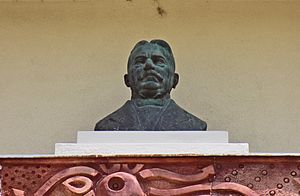
Mihajlo Pupin released about 70 technical articles and reviews. He also held 34 patents for his inventions. Here are some of his patents released in America:
| Number of patent | Date |
|---|---|
| U.S. Patent 519,346 Apparatus for telegraphic or telephonic transmission | 8 May 1894 |
| U.S. Patent 519,347 Transformer for telegraphic, telephonic or other electrical systems | 8 May 1894 |
| U.S. Patent 640,515 Art of distributing electrical energy by alternating currents | 2 January 1900 |
| U.S. Patent 640,516 Electrical transmission by resonance circuits | 2 January 1900 |
| U.S. Patent 652,230 Art of reducing attenuation of electrical waves and apparatus therefore | 19 June 1900 |
| U.S. Patent 652,231 Method of reducing attenuation of electrical waves and apparatus therefore | 19 June 1900 |
| U.S. Patent 697,660 Winding-machine | 15 April 1902 |
| U.S. Patent 707,007 Multiple telegraphy | 12 August 1902 |
| U.S. Patent 707,008 Multiple telegraphy | 12 August 1902 |
| U.S. Patent 713,044 Producing asymmetrical currents from symmetrical alternating electromotive process | 4 November 1902 |
| U.S. Patent 768,301 Wireless electrical signalling | 23 August 1904 |
| U.S. Patent 761,995 Apparatus for reducing attenuation of electric waves | 7 June 1904 |
| U.S. Patent 1,334,165 Electric wave transmission | 16 March 1920 |
| U.S. Patent 1,336,378 Antenna with distributed positive resistance | 6 April 1920 |
| U.S. Patent 1,388,877 Sound generator | 3 December 1921 |
| U.S. Patent 1,388,441 Multiple antenna for electrical wave transmission | 23 December 1921 |
| U.S. Patent 1,415,845 Selective opposing impedance to received electrical oscillation | 9 May 1922 |
| U.S. Patent 1,416,061 Radio receiving system having high selectivity | 10 May 1922 |
| U.S. Patent 1,456,909 Wave conductor | 29 May 1922 |
| U.S. Patent 1,452,833 Selective amplifying apparatus | 24 April 1923 |
| U.S. Patent 1,446,769 Aperiodic pilot conductor | 23 February 1923 |
| U.S. Patent 1,488,514 Selective amplifying apparatus | 1 April 1923 |
| U.S. Patent 1,494,803 Electrical tuning | 29 May 1923 |
| U.S. Patent 1,503,875 Tone producing radio receiver | 29 April 1923 |
Awards and Recognitions
Mihajlo Pupin received many honors and tributes throughout his life:
- President of the Institute of Radio Engineers, USA (1917)
- President of American Institute of Electrical Engineers (1925–26)
- President of American Association for the Advancement of Sciences
- President of New York Academy of Sciences
- Honorary member of German Electrical Society
- Honorary member of American Institute of Electrical Engineers
- Member of National Academy of Sciences
- Member of French Academy of Sciences
- Member of Serbian Academy of Sciences and Arts
- Member of American Mathematical Society
- Member of American Philosophical Society
- Member of American Physical Society
- Honorary Degrees
- Doctor of science, Columbia University (1904)
- Honorable doctor of science, Johns Hopkins University (1915)
- Doctor of science, Princeton University (1924)
- Honorable doctor of science, New York University (1924)
- Honorable doctor of science, Muhlenberg College (1924)
- Doctor of engineering, Case School of Applied Science (1925)
- Doctor of science, George Washington University (1925)
- Doctor of science, Union College (1925)
- Honorable doctor of science, Marietta College (1926)
- Honorable doctor of science, University of California (1926)
- Doctor of science, Rutgers University (1926)
- Honorable doctor of science, Delaware University (1926)
- Honorable doctor of science, Canyon College (1926)
- Doctor of science, Brown University (1927)
- Doctor of science, Rochester University (1927)
- Honorable doctor of science, Middlebury College (1928)
- Doctor of science, University of Belgrade (1929)
- Doctor of science, University of Prague (1929)
- Medals and Awards
- Eliot Kresson Medal, Franklin Institute (1902)
- Herbert award, French Academy of Sciences (1916)
- IEEE Edison Medal, American Institute of Electrical Engineers (1919)
- Honorable medal, American Radio Institute (1924)
- IEEE Medal of Honor (1924)
- George Washington Award, Western Society of Engineers (1928)
- White eagle, first degree, Kingdom of Yugoslavia (1929)
- Order of the White Lion of Czech-Slovakia (1929)
- John Fritz Medal, American Association of Engineering Societies (1931)
- Other Tributes
- Pupin's face was on the old 50 million Yugoslav dinar banknote.
- On October 9, 2011, Google's homepage celebrated Pupin's 157th birthday. The drawing showed a boy and a girl talking on the phone from two different hills, symbolizing his work.
- The Central Radio Institute was renamed the Telecommunication and Automation Institute "Mihailo Pupin" in 1956.
- A small lunar impact crater on the Moon was named in his honor.
- He served on the board of trustees for Science Service (now Society for Science & the Public) from 1926 to 1929.
- He was made an honorary citizen of the cities of Zrenjanin, Ohrid, and Municipality of Bled.
- Many streets and schools in Serbia are named after him. The Boulevard of Mihajlo Pupin in Belgrade and the Mihajlo Pupin gymnasium are famous examples.
- A road bridge over the Danube River in Belgrade was named Pupin Bridge after citizens voted for it.
Private Life
After moving to America, he changed his name to Michael Idvorsky Pupin. He added "Idvorsky" to highlight his hometown. His father was Constantine and his mother was Olimpijada. Pupin had four brothers and five sisters.
In 1888, he married Sarah Catharine Jackson from New York. They had one daughter named Barbara Ivanka Pupin, born in 1899. Sadly, Pupin's wife died from pneumonia at age 37, after eight years of marriage.
Pupin was known not only as a great scientist but also as a kind person. He was polite, very knowledgeable, and loved his homeland. He was a generous philanthropist and supported the arts. He was also a devoted Orthodox Christian.
Mihajlo Pupin passed away in New York City in 1935 at the age of 76. He was buried at Woodlawn Cemetery, Bronx.
Legacy
Mihajlo Pupin is included in the list of The 100 most prominent Serbs. His work continues to inspire scientists and engineers today.
See also
 In Spanish: Michael Pupin para niños
In Spanish: Michael Pupin para niños
- List of Serbs
- Nikola Tesla
- Memorial Complex in Idvor (Mihajlo Pupin)


